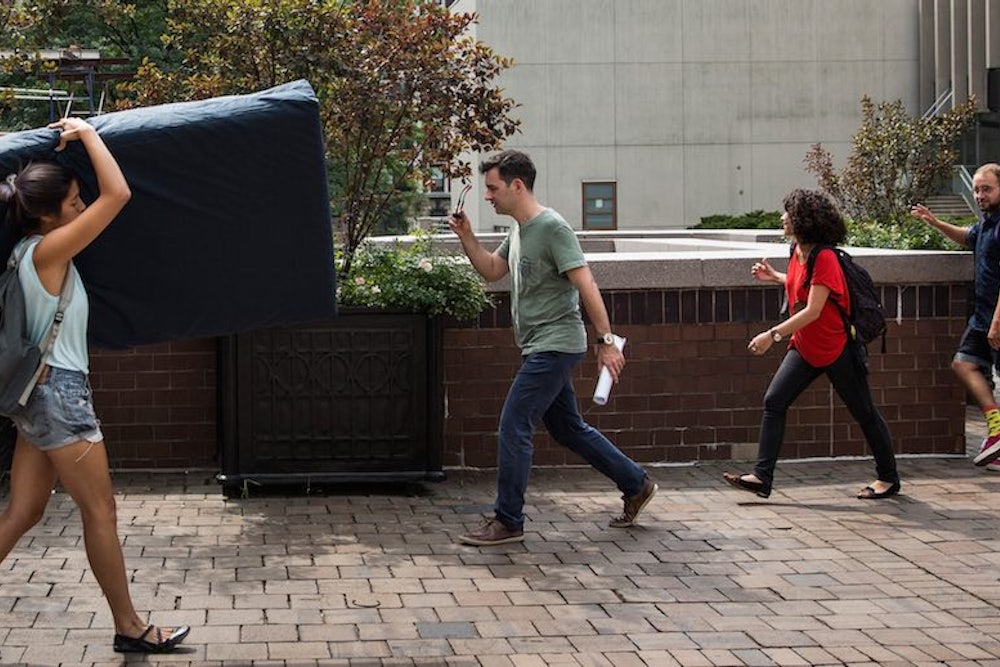Despite an overall decline in violence against women, 2014 was the year that campus rape gained legal traction and national attention. Citing data that one in five college women are sexually assaulted, a White House Task Force called for universities to lower the standard of proof necessary to find guilt in a sexual assault claim. The California legislature even passed a bill that tied state funding of higher education to a campus policy of affirmative consent or “yes means yes,” meaning that even if a college student didn’t say “No” to a sexual advance, he (but more likely, she) can pursue a claim for having failed to “assent affirmatively.”
The prominence of campus rape as a political and feminist issue was the result of a host of factors, including long-gestating changes to Title IX and the work of campus activists and journalists. Much of this work was meaningful and brave. But by the end of the year, signs began to emerge that the collective panic over campus sexual assault may have been a little misguided. First, there was the Rolling Stone debacle. So desirable had stories of campus sexual assault become, that the magazine’s reporter, Sabrina Rubin Erdely, hunted until she found one at the University of Virginia that implicated everyone imaginable—the school’s administrators, fraternities, and ordinary students. It turned out that Erdely’s reporting was unsubstantiated and, in several key aspects, untrue. In the aftermath, many people insisted that we not use the incident to cast doubt on other rape survivors’ stories. And while this is undoubtedly correct, it’s also true that the Rolling Stone story wasn’t merely an isolated incident—that the collective hysteria surrounding campus rape lulled the magazine’s editors and readers into letting down their critical faculties.
As Erdely’s story crumbled, new data emerged to suggest that campus rape was not quite the pandemic that had been described. According to new research conducted by the Department of Justice that came out in December, the oft-cited statistic that one in five women in college will be sexually assaulted is actually a wildly inflated tally, based on self-selecting surveys. But a new study in December put the actual number of female college students aged 18-24 who will experience sexual assault at 6.1 per 1,000 students.
“This is nothing to be proud of,” Professor Callie Marie Rennison, a co-author of the study, wrote in an op-ed in the New York Times. But it’s also not one in five.
“I think people have lost context,” Rennison said, when reached by phone. The study also found that women of the same age who don’t attend college are sexually victimized at rates 30 percent greater than their more educated counterparts. “The context is, yeah, college women are victimized, but non-college women are victimized at much higher rates, and I don’t hear anyone talking about them.”
So why all the focus on college campus assault? “It makes for great media stories,” said Rennison, who also suggested that the locality of campus rape may also account for its popularity as a cause. “Maybe it’s a really easy one to tackle. We’ve got a campus and we can put some services in this campus, and we feel good. Whereas when you’re talking about poor people, or people without so much power, where do you go to help them? They are everywhere.”
In treating campus rape as a staggering problem, activists have put forward some deeply problematic solutions. Judith Shulevitz has described the way universities are trampling on the rights of men accused of sexual assault. Twenty-eight law professors wrote a letter to oppose Harvard’s decision to create a centralized office to investigate allegations for addressing sexual assault; they said the new system violated the due process they teach their students every day. Stories by Cathy Young and Emily Yoffe echoed the Harvard professors’ fears—telling stories of men whose right to due process has been terribly violated. Universities have in recent years paid as much as $36 million in insurance claims, 72 percent of which went to the accused.
The focus on campus sexual assault has also led to the bizarre policing of young adult sexuality. “College students today are increasingly treated as a special sexual caste,” wrote Emily Yoffe in Slate, “who unlike their peers out in the working world can’t be relied upon to have sex without convoluted regulations that treat lovemaking as if it were a contract negotiation.”
But the focus on the most privileged victims of sexual assault over and above victims who are more at risk should not surprise us. “It’s an eternal tension in feminism,” Hanna Rosin, author of The End of Men, told me. “Middle class issues start the conversation and then trickle down or don’t trickle down.”
Lower down the economic ladder, several issues seem more important political causes than campus rape. 2014 was not the year paid sick leave was finally granted to mothers across the United States. It was not the year that the startling drop in life expectancy of uneducated women was understood, let alone treated. It was not the year that daycare became accessible and affordable, as it is in many other developed countries, allowing hundreds of thousands of poor and middle class women back into the workforce. In fact, the share of mothers who do not work outside the home rose to 29 percent in 2012, up from a modern-era low of 23 percent in 1999, according to a Pew Research Center.
“The bottom line is, there's a lot more effort going into gender-based issues faced by women who don't have kids (street harassment, campus rape, abortion) than there is going into helping out women who do have kids,” said feminist writer Elissa Strauss. “Look closely at the numbers surrounding the wage gap, and you'll see that becoming a mother is still the biggest liability for women, and all women.”
